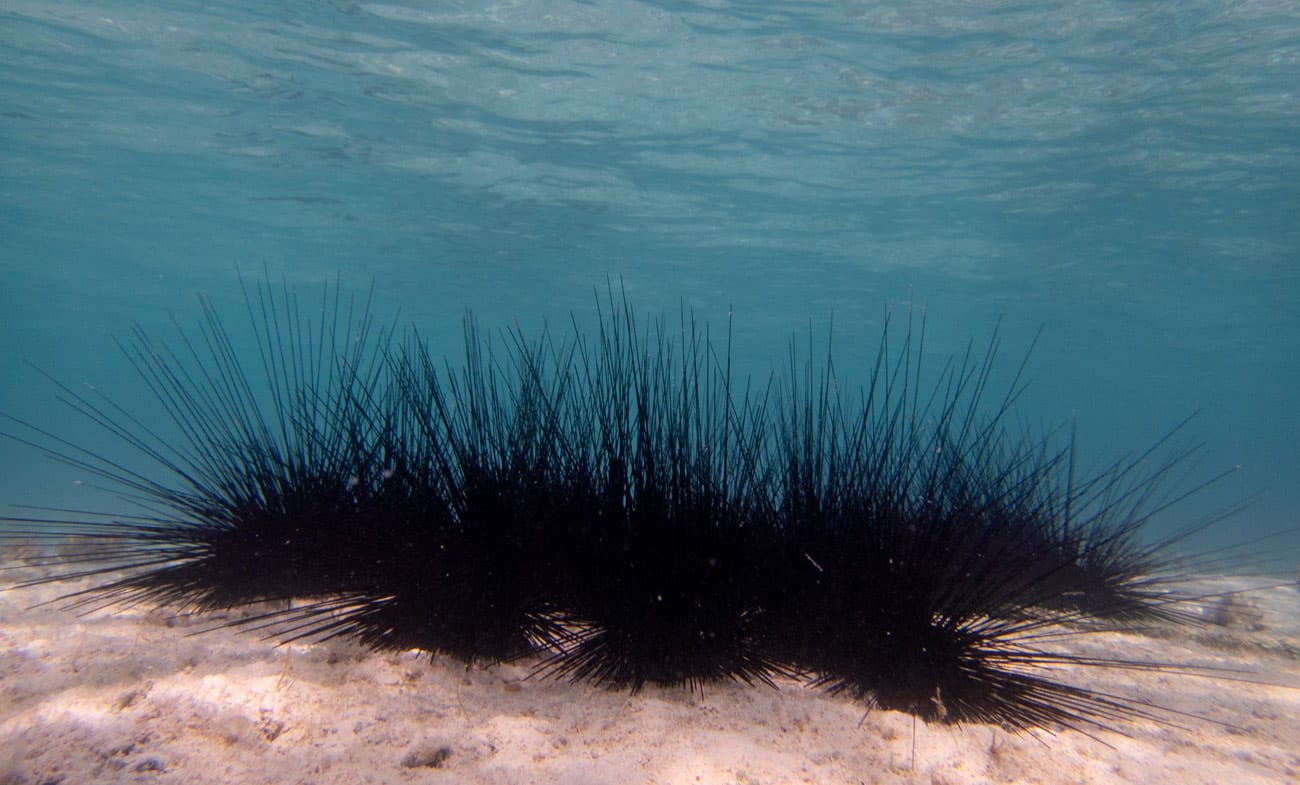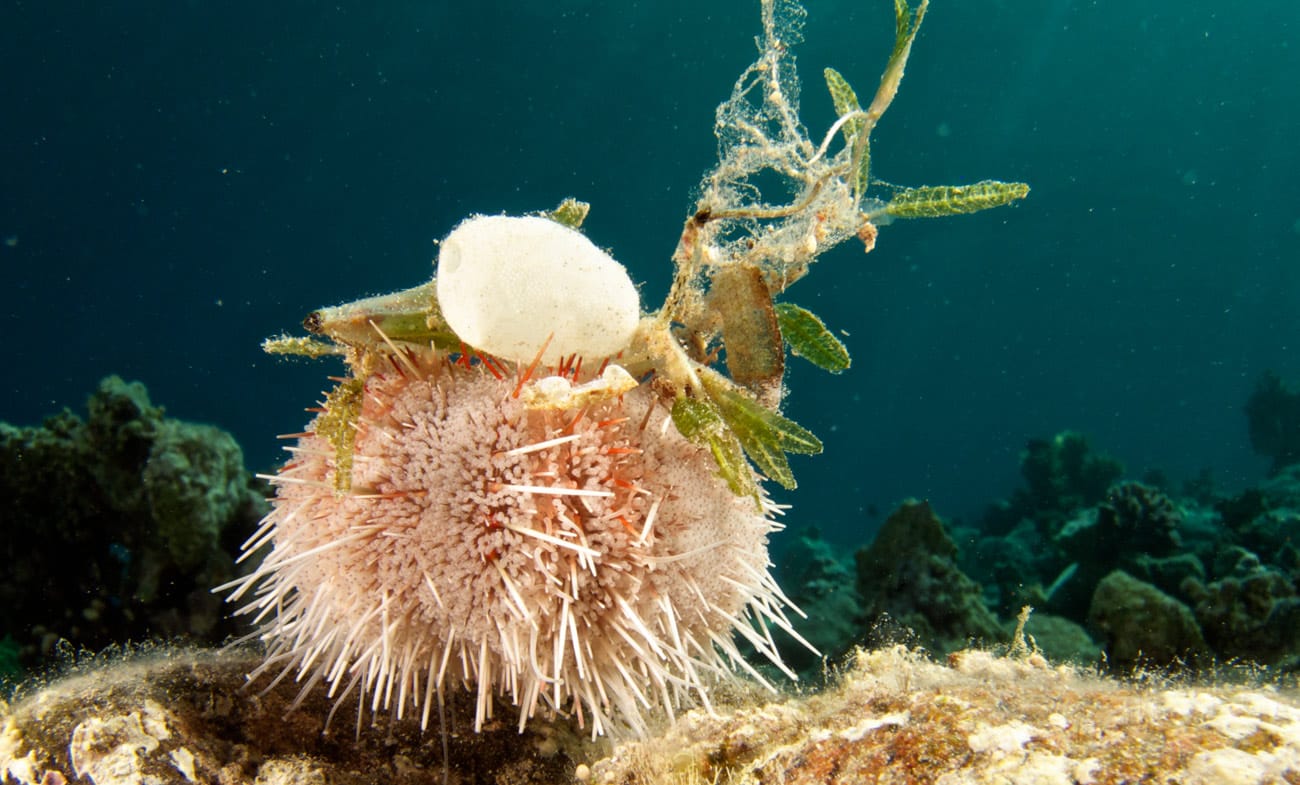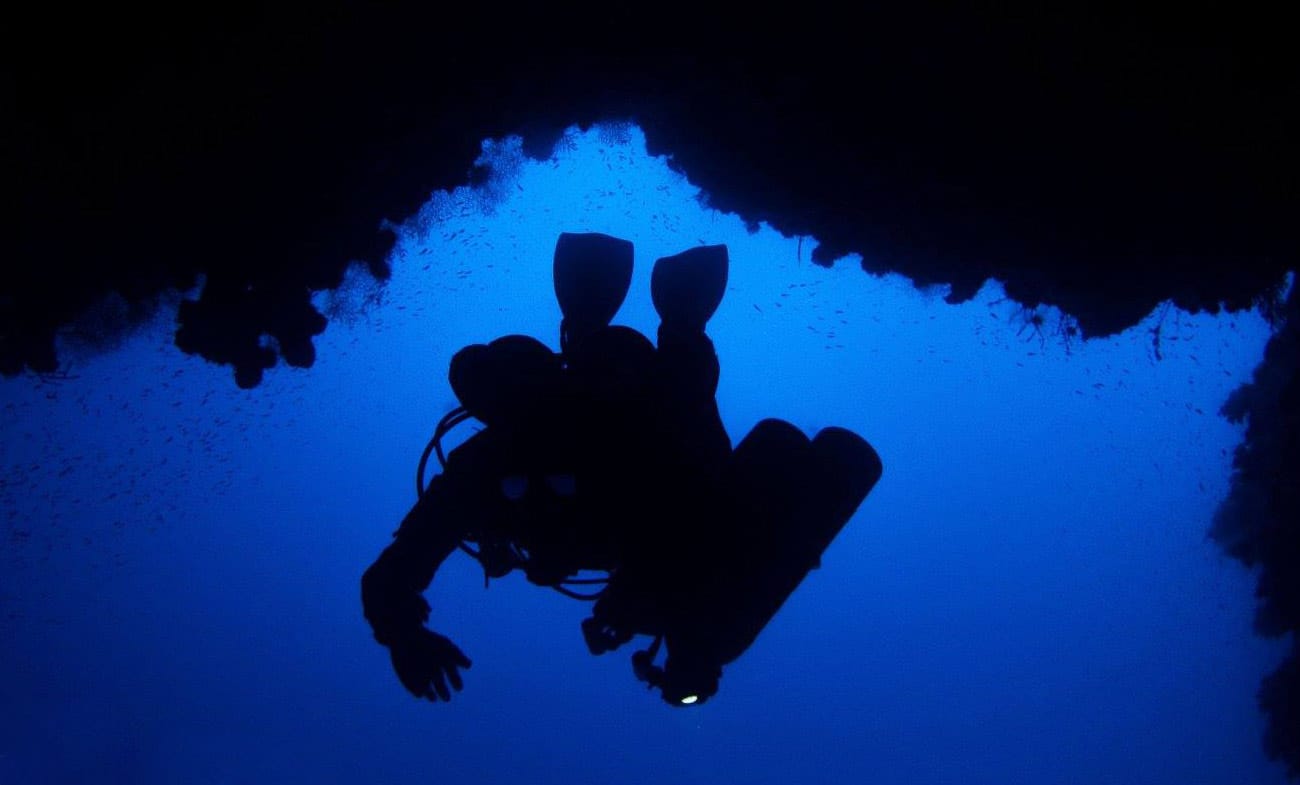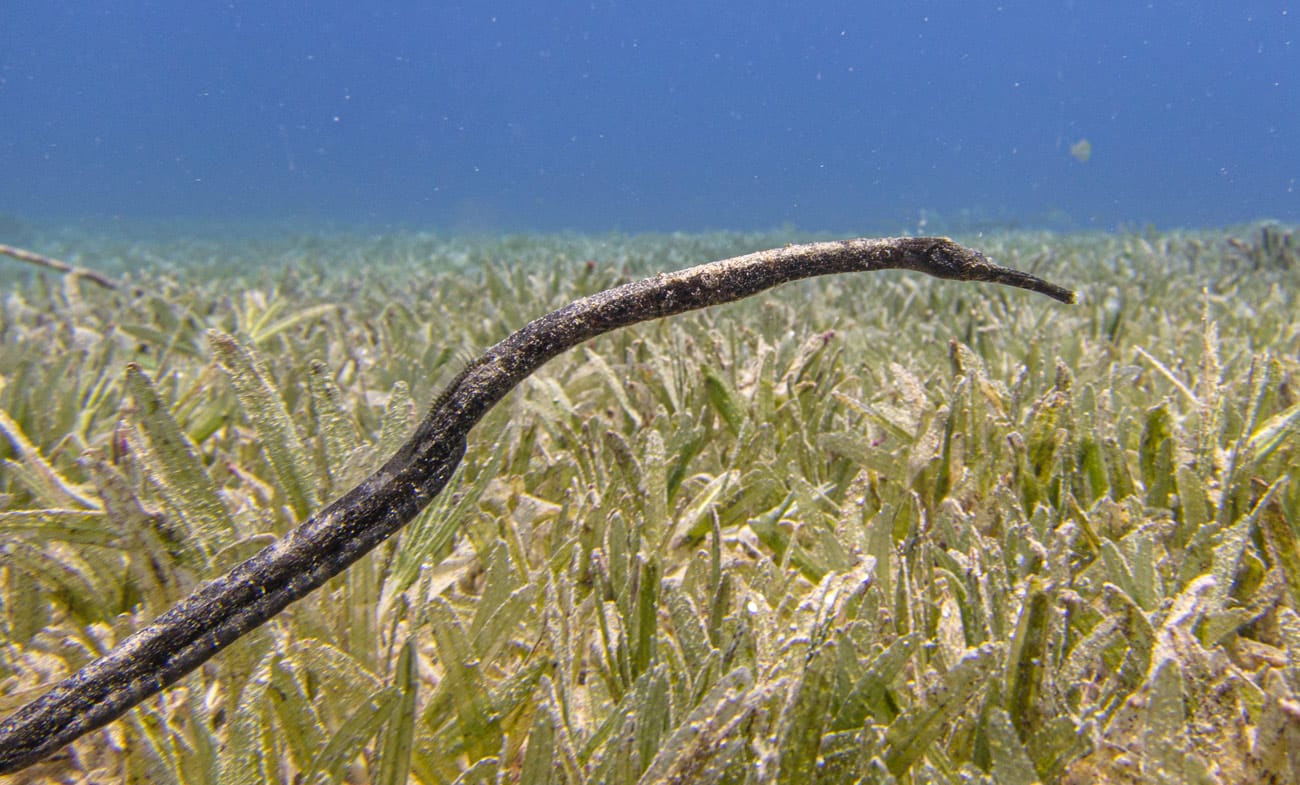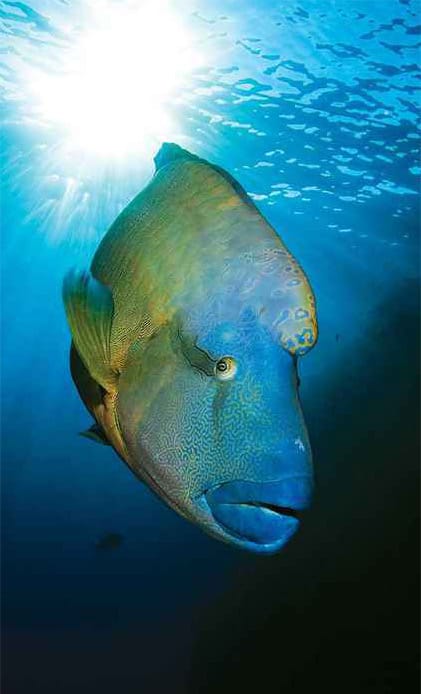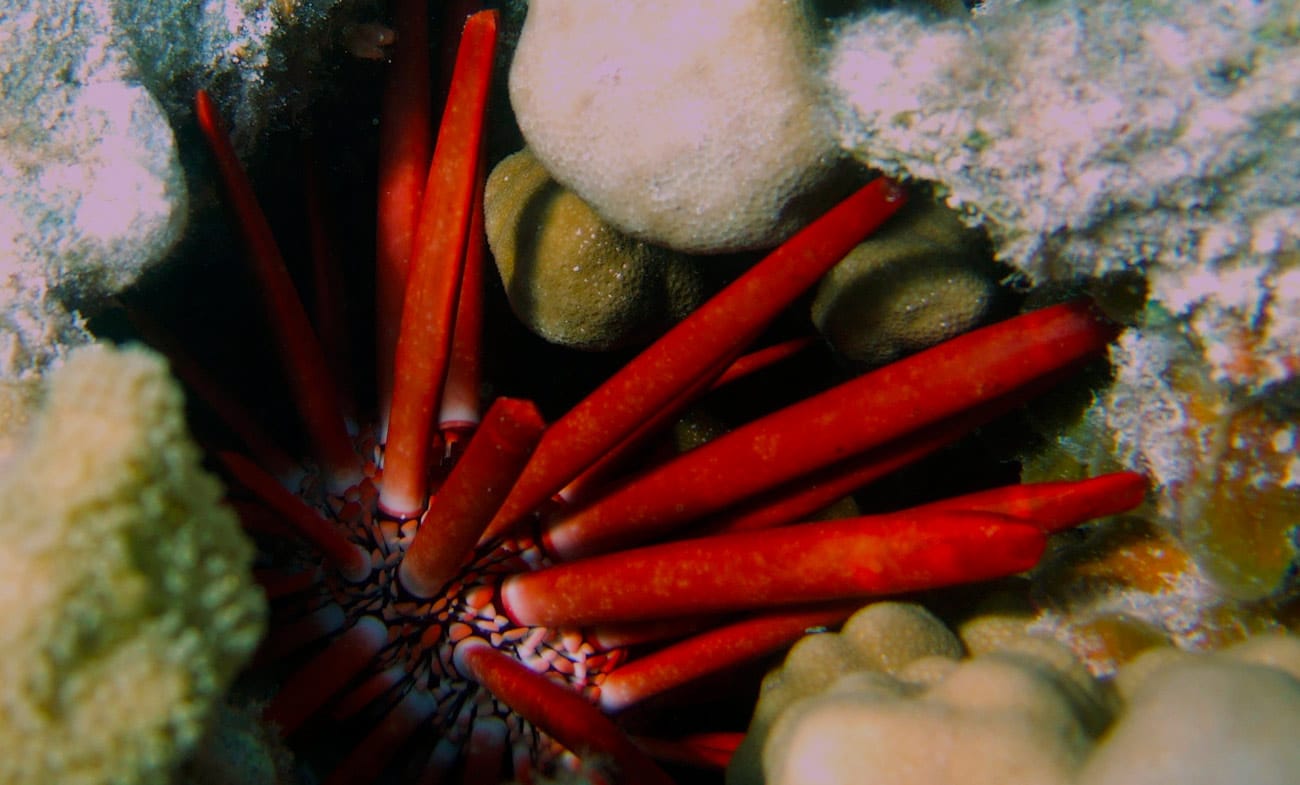
Why did the hedgehog cross the road?
to see his flat mate. Bada-boom!
OK, by ‘hedgehog’ I mean ‘sea urchin’ and by ‘road’ I mean ‘reef’. There is no punch line to that however. But Urchin is the Middle English term for Hedgehog so it links nicely in to my blog about sea urchins.
Despite being black and spiky, these animals aren’t impervious to human destruction. They don’t look like the most appetising ingredient and yet they are used in such recipes like Sea urchin bruschetta and Sea urchin mousse. They don’t actually use their spines in these recipes (although I guess that they could be a nifty toothpick afterwards) Instead they use the middle part of the urchin; crack the shell and you will get their roe. The roe is their egg masses, for want of a better description. They can be found as deep as 6000m in the Java trench, to very shallow waters in most seas. It is here that many of them meet their fate: being stepped on. People don’t look where they’re going when they walk around in the sea, but they sure feel it after stepping on one of these bad boys. To be fair urchins do enjoy hanging around in rocky parts of the reef so they may not be that obvious. Their spines actually are pretty brittle and made mostly of calcium carbonate, magnesium carbonate and silica. However that doesn’t mean they don’t freaking hurt! Similar to the pain of stubbing your little toe on the corner of the bed – this pain gets worse over time.
As said, the spines are brittle, so removing them is pretty delicate work. The good news is that due to their make-up the spines are pretty easily absorbed by your blood and when people leave the spines in they tend to disintegrate over time. Simply: take painkillers for the pain and if the area gets infected – go for the antibiotics. Better still… watch where you’re going.
As I am not a Doctor, I would like not to be sued if you follow my advice and your arm falls off. So, check out Divers Alert Network for further info if you do assertively encounter one of these docile creatures
There is no universally accepted treatment for sea-urchin puncture wounds. Both first aid and definitive care is symptomatic.
1. APPLY HEAT
Immerse the affected area in hot water (upper limit of 113°F/45°C) for 30 to 90 minutes. If you are assisting a sting victim, try the water on yourself first to assess tolerable heat levels. Do not rely on the victim’s assessment, as pain may impair his ability to evaluate tolerable heat levels. If you cannot measure water temperature, a good rule of thumb is to use the hottest water you can tolerate without scalding. Note that different body areas have different tolerance to heat, so test the water on the same area where the diver was injured. Repeat if necessary.
NOTE: Very few species of sea urchins contain venom. If venom is present, hot-water immersion may also help denature any superficial toxins.
2. REMOVE ANY SUPERFICIAL SPINES
Tweezers can be used for this purpose; however, sea-urchin spines are hollow and can be very fragile when grabbed from the sides. Your bare fingers are a softer alternative to hard tweezers.
NOTE: Do not attempt to remove spines embedded deeper in the skin; let medical professionals handle those. Deeply embedded spines may break down into smaller pieces, complicating the removal process.
3. WASH THE AREA THOROUGHLY
What the area throughly but avoid forceful rubbing and scrubbing if you suspect there may still be spines embedded in the skin.
4. APPLY ANTISEPTIC SOLUTIONS
Apply antiseptic solutions or over-the-counter antibiotic ointments if available.
5. DO NOT CLOSE THE WOUND WITH TAPE OR GLUE
This might increase the risk of infection.NOTE: Deep puncture wounds are the perfect environment to culture an infection, particularly tetanus.
6. SEEK PROFESSIONAL MEDICAL EVALUATION
Regardless of any first aid provided, always seek a professional medical evaluation.
On to their natural predators, which include but aren’t limited to: otters, crabs and triggerfish. They’re omnivores, so left unchecked they can wreak havoc on a reef; their prey including algae, mussels, brittle stars, sponges and sea cucumbers – notice the lack of quick-moving creatures in that list. Their mouth is on the bottom, so you won’t actually see it. But their ass is on the top. You can see it on a night dive easily when you shine your torch on one, it looks like an eye on a stalk and it rotates 360 around itself – they literally shake their booty.
They can actually walk, but obviously they’re not going to win any speed races. Their spines are attached to their body by a ball and socket joint, much like our hips. They can therefore angle their spines in many directions and if you notice on a dive, if they feel threatened they will move all their spines to that part of their body. Their spines are coated with tube-like ‘feet’ and they can use these feet to pick up things too. Some species pick up rocks, dead coral (they’ve read up on PADI Project AWARE) and shells and they give them a big urchin-hug. Sciency people call this behaviour ‘covering’ and they think that it’s to protect them from predators and strong currents. I always figured the bits of rock and what-have-you just got caught up in them by water movement.
A lot of people think that sea urchins are venomous, in fact this is largely untrue. Only a couple of species are. The swelling and subsequent pain after you get punctured by one is just the body’s natural reaction to the antigens in the spine – such as a splinter would. There of course a few toxic variations most notably the flower sea urchin (Toxopneustes spp.) is the most toxic of all sea urchins. As harmless as it looks (like small flowers) they’re actually small claws which can give out a similar severe pain to that of a bad jellyfish sting. We don’t have them here in Dahab however, so we’re all good. They’re found in the Indo-West Pacific.
Sea urchins are called echinoderm, coming from the family of animals which starfish, sand dollars and sea cucumbers do. They have 5 rays of symmetry (pentaradial) which you can see easily in starfish. Please don’t do this: but you can also see it if you chop the sea cucumbers in half, or break the spines from an urchin. Underneath the spines, is something called a test – it’s basically the fragile eggshell around their eggs. It is on this test that you can see their five-fold summery.
Around Dahab there’s a few common types you are likely to see on most dives: Blue-black urchin which has banded white stripes when they’re growing up, Common long-spined which is very similar to the Blue-black but generally with very long spines, slate-pencil urchin and the banded urchin.



